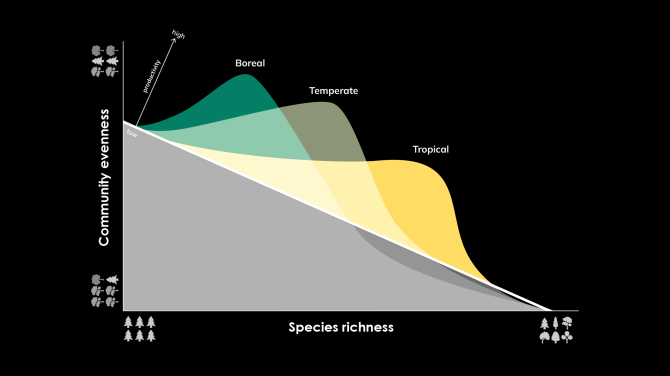
News
The evenness of tree species abundance is key to increasing forest growth
High forest productivity (the increase of biomass) is not only the result of how many different tree species occur in a forest, but also how abundant the species are. Typically, a greater number of species increases an ecosystem’s biomass. However, a new study shows that the effects of diversity on productivity are not only a matter of species richness. If many species coexist in a forest, even distribution of species abundances is key for high ecosystem diversity and growth.
Biodiversity is an essential factor for ecosystem health and productivity. A higher biodiversity generally leads to a higher productivity (the increase of biomass in an ecosystem, which for example enables forests to store more carbon). Indeed, the number of species in a forest has been found to positively correlate with its productivity. Previous research, however, has also pointed to a limit in increasing forest productivity at a high number of coexisting species. What is the reason?
Species abundance
A new publication in Journal of Ecology provides evidence at global scale that the number of species, also known as species richness, is not sufficient to measure the effect of biodiversity on forest productivity. Biodiversity is a product of species richness, but also the relative abundance of species in the community (evenness). Evenness refers to the distribution of species abundance: for example, a plot with 50 trees and 5 species at each 10 trees can be considered even. However, a forest plot with 46 trees of one species but one each of the others would be considered uneven.
Forests with high species-count tend to uneven distribution
The research team consisted of a large number of international collaborators, among others of Wageningen University & Research, who collected data from forests all over the world. Based on data from over one million forest plots, the study shows that there is a negative relationship between the richness and the evenness of species within forests around the world. Forests with a high species count therefore tend to be highly uneven, with a few species dominating the community, while the majority of species are rare. In these cases, evenness will be more important for improving forest productivity than increasing the number of species.

Dr. Iris Hordijk, lead author of the study summarises: “This study suggests that
trees in a species rich forest need to be present in high enough numbers to
contribute to the productivity of the forest.” The study was part of Hordijk’s
PhD research which she undertook at Crowther Lab, ETH Zürich. Currently
she works at Wageningen University & Research as a postdoctoral researcher,
focussing on the recovery of tropical forest.
Promoting the natural evenness of species
Overall, the study demonstrates the importance of species evenness in influencing forest diversity and productivity. At a time when diverse and productive forests are needed to fight climate change and biodiversity loss, understanding the role of species abundances is critical for guiding ecosystem conservation and management efforts. Prof. Thomas Crowther of Crowther Lab, ETH Zurich and senior author of the paper explains: “Increasing a forests’ diversity doesn’t only mean increasing the number of species. It can also mean working to promote the natural evenness of those species.”